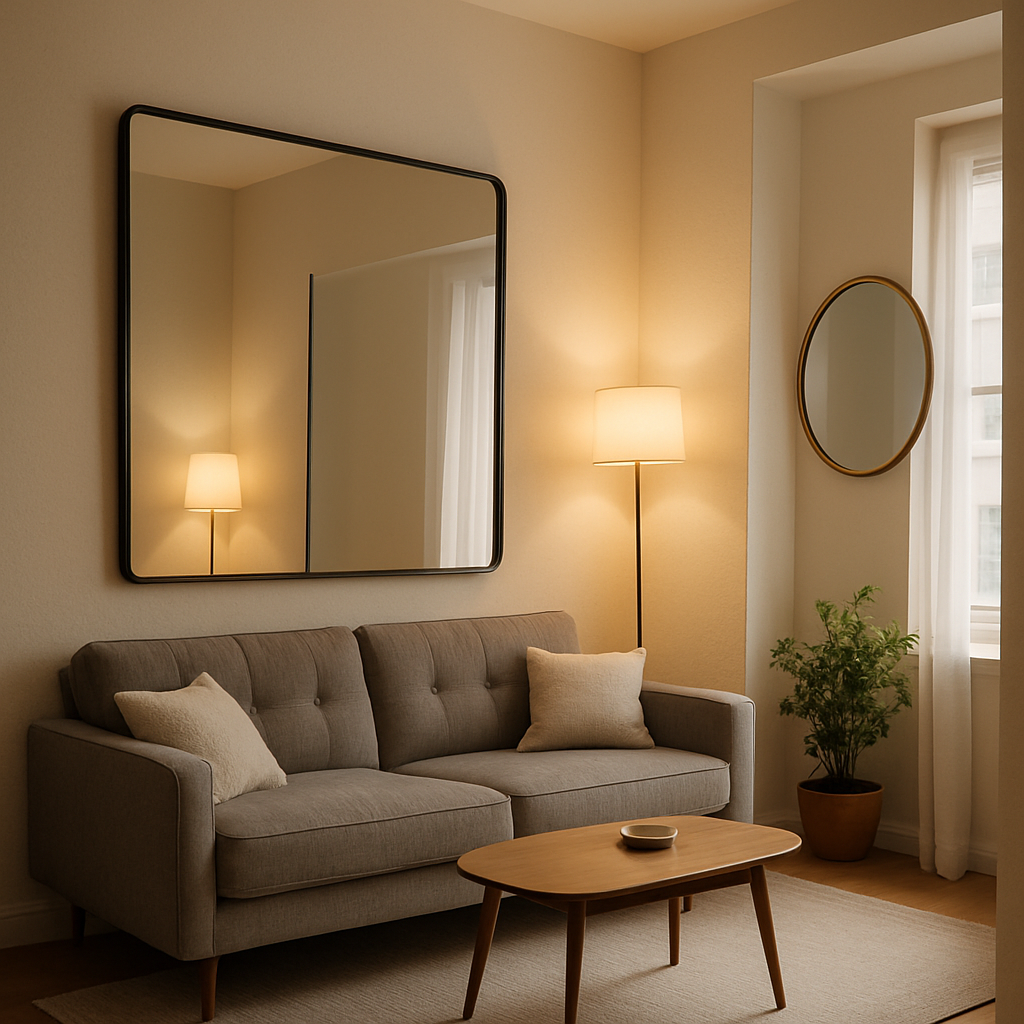
Small spaces present unique challenges and opportunities for homeowners and renters alike. Whether you’re living in a compact apartment, a tiny house, or just dealing with that awkward corner in your bedroom, maximizing your space is essential for comfortable living. Strategic use of mirrors and lighting can transform even the most cramped quarters into areas that feel spacious, functional, and inviting.
The optical illusions created by reflective surfaces and thoughtful illumination aren’t just design tricks they’re practical solutions that can dramatically alter how we perceive and experience our living environments. By understanding a few fundamental principles and applying some creative techniques, you can make any small space feel considerably larger without moving a single wall.
The Magic of Mirrors in Small Spaces
Mirrors work wonders in compact areas. They reflect both natural and artificial light, creating the illusion of depth where there isn’t any. I’ve transformed my own 400-square-foot studio apartment using this principle, and the difference was night and day.
A large mirror positioned opposite a window doubles the amount of natural light in the room and creates a visual extension of the space. When I placed a full-length mirror across from my only window, it instantly made my living area feel twice as bright and significantly more open. The reflection captured the outdoor greenery too, bringing a bit of nature inside my urban box.
The placement of mirrors matters tremendously. Rather than randomly hanging mirrors wherever there’s wall space, think strategically about what the mirror will reflect. Ideally, you want mirrors to reflect something visually appealing perhaps a window with a nice view, a beautiful light fixture, or an interesting piece of art. This not only doubles the impact of these features but also adds depth to your space.
For particularly small rooms, consider using mirrored furniture pieces like side tables or cabinets with mirrored panels. These items serve their functional purpose while simultaneously helping to visually expand the space. I added a mirrored coffee table to my living room, and it practically disappears visually while reflecting my ceiling light in beautiful patterns.
Don’t limit yourself to traditional mirror shapes either. Clusters of smaller mirrors can create artistic installations while serving the practical purpose of space expansion. Mirrors with interesting frames can double as decorative elements, adding personality to your space while performing their light-reflecting duties.
One technique I’ve found particularly effective is using mirrors to create “windows” in windowless spaces. A large mirror framed to look like a window can trick the eye into perceiving another room or outdoor space beyond. This works especially well in hallways, bathrooms, or other enclosed areas that tend to feel claustrophobic.
Just be careful not to overdo it too many mirrors can create a disorienting fun-house effect. Balance is key. My friend went a bit mirror-crazy in her studio apartment, and dinner guests kept walking into walls! A few strategically placed mirrors will serve you better than covering every available surface.
Illuminating Small Spaces Effectively
Lighting is just as crucial as mirrors when it comes to making small spaces feel larger and more inviting. Poor lighting can make even spacious rooms feel cramped and uncomfortable, while well-planned lighting can open up the tightest corners.
The first rule of lighting small spaces is layering. Relying solely on overhead lighting creates harsh shadows and flattens the room. Instead, incorporate multiple light sources at different heights: floor lamps, table lamps, wall sconces, and perhaps some string lights for ambiance.
I transformed my tiny bedroom by replacing the single ceiling fixture with a combination of wall-mounted reading lamps, a small table lamp on my nightstand, and LED strip lighting along the top of my bookshelf. The result was a room that felt larger, cozier, and more functional for different activities.
Consider the color temperature of your light bulbs too. Cooler, bluer lights (around 4000-5000K) create an effect similar to daylight and can make spaces feel more open and airy. Warmer lights (2700-3000K) create a cozier, more intimate atmosphere. For maximum flexibility, smart bulbs that allow you to adjust both brightness and color temperature give you the best of both worlds.
Directional lighting is another powerful tool. Uplighting (directing light toward the ceiling) draws the eye upward, creating the perception of height in rooms with low ceilings. Wall washing (aiming light to spread evenly across a wall) can make walls appear to recede, visually expanding the space.
Don’t forget about natural light it’s free and unbeatable for making spaces feel open. Remove heavy drapes that block windows and replace them with sheer curtains or blinds that can be fully opened during the day. Keep windows clean (yes, it makes a difference!) and arrange furniture so it doesn’t block light from entering the room.
For rooms with limited natural light, consider light tubes or solar tubes if your situation allows for installation. These relatively inexpensive additions channel natural light from your roof into interior spaces, providing genuine daylight where windows aren’t possible.
Built-in lighting can save precious space while providing excellent illumination. Under-cabinet lights in kitchens, recessed lighting in ceilings, and LED strips along shelving not only save space that would otherwise be occupied by lamps but also highlight architectural features and create depth.
One of my favorite lighting tricks for small spaces is using adjustable fixtures. A swing-arm wall lamp can provide task lighting over a desk, reading light over a chair, or ambient lighting for the room all while taking up minimal space and adapting to different needs throughout the day.
Combining Mirrors and Lighting for Maximum Impact
The real magic happens when you strategically combine mirrors and lighting. This pairing creates a multiplicative effect that can dramatically transform even the most challenging spaces.
Placing mirrors to reflect light sources effectively doubles your lighting without additional electricity costs. A mirror placed adjacent to a lamp or across from a window captures and redistributes light throughout the space. I positioned a floor lamp next to a large mirror in my narrow hallway, and the difference was striking what was once a dark passage became a bright, welcoming entrance.
Consider placing candles or small lamps in front of mirrors for intimate evening lighting. The reflection creates depth and a romantic atmosphere perfect for small dining areas or bedrooms. The flickering light reflected in the mirror adds movement and life to static spaces.
Mirrored backsplashes in kitchens paired with under-cabinet lighting make countertop spaces feel larger while improving task lighting for cooking. This combination is particularly effective in galley kitchens or small cooking spaces where both light and a sense of openness are at a premium.
For bathrooms, which are often small and poorly lit, a large mirror combined with good lighting around the mirror can transform the space from claustrophobic to spa-like. I upgraded my tiny bathroom with a large frameless mirror and wall sconces on either side instead of the typical overhead light. The result was dramatically better lighting for grooming tasks and a bathroom that suddenly felt twice as large.
Don’t overlook reflective surfaces beyond traditional mirrors. Glossy ceramic tiles, metallic fixtures, glass tabletops, and polished surfaces all contribute to light reflection and space expansion. My kitchen feels much larger after I replaced the matte backsplash with glossy subway tiles that bounce light around the space.
Mirrors placed perpendicular to windows can capture and direct natural light deeper into rooms. This technique is particularly useful in railroad-style apartments or any space where windows are limited to one wall. The mirror essentially creates another “window” of light on an adjacent wall.
Remember that both mirrors and lighting can be adjusted seasonally. During darker winter months, you might want to add more light sources and perhaps larger or additional mirrors to compensate for reduced natural light. In summer, when natural light is abundant, you can rely more heavily on the mirror placement to distribute that light throughout your space.
Transforming small spaces with mirrors and lighting isn’t just about creating illusions it’s about making spaces more functional, comfortable, and aligned with how you actually live. These techniques can turn cramped quarters into cozy, welcoming environments that feel spacious enough for both everyday living and entertaining friends.
The best part? Unlike major renovations, most mirror and lighting solutions are relatively inexpensive and non-permanent, making them perfect for renters or anyone wanting to transform their space without a major commitment. With some thoughtful planning and creative implementation, you can use these principles to make your small space feel just right no matter its actual dimensions.

